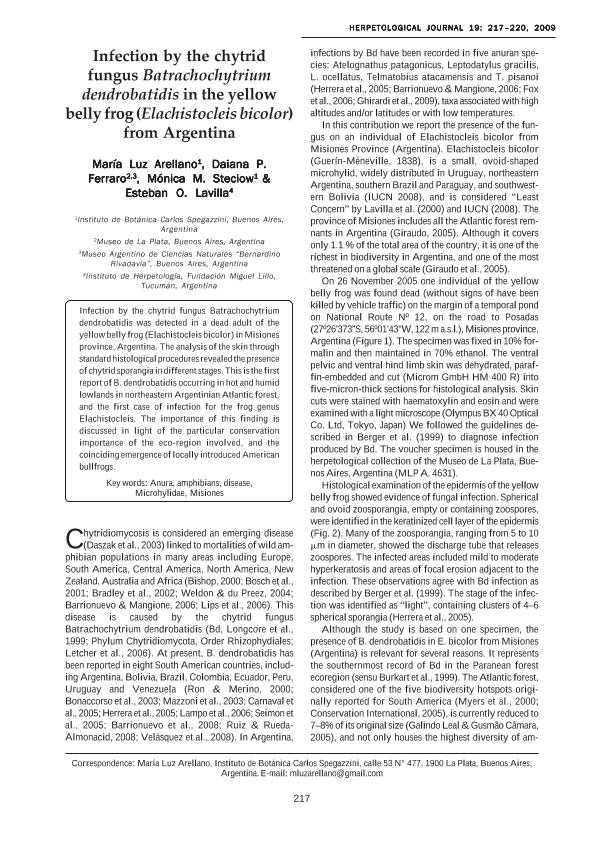Artículo
Infection by the chytrid fungus Batrachochytrium dendrobatidis in the yellow belly frog (Elachistocleis bicolor, Anura: Microhylidae) from Argentina
Fecha de publicación:
12/2009
Editorial:
British Herpetological Society
Revista:
Herpetological Journal
ISSN:
0268-0130
Idioma:
Inglés
Tipo de recurso:
Artículo publicado
Clasificación temática:
Resumen
From August 2002 through July 2004, the 24-hour time budget and activity rhythm of 15 captive, wild-caught, adult Sacalia quadriocellata (eight females, seven males) from Qiongzhong, Hainan Island, was observed by all-occurrence and scan sampling methods. The results showed that S. quadriocellata spends most of its time resting (mean 96.9%) and little time on moving (mean 3%) and feeding (mean <1%). Some differences occurred between females and males in time budget. Females spent significantly more time moving than males and less time resting. There was no difference between females and males in feeding behaviour. ANOVA indicated inter-individual variation in both females and males in all behaviours, except for “other” behaviour by males. Variation among females was greater than that in males. This discrepancy may have reflected different roles in reproduction. All behaviours had significant daily rhythms. Daily movement peaked from 0700 to 1300 and from 1900 to 0300 the next day. The feeding rhythm peaked from 0700 to 0900 and from 1900 to 0300 next day. The other behaviours showed pulse-like rhythms. Compared to movement in the field, peak times in captivity were largely coincident, although their peak and sub-peak times overlapped. This overlap probably resulted from differences in seeking food. Annually, the rhythm in moving peaked from April through September. The annual feeding rhythm peaked from April through September. Both of these rhythms had significant annual variation. Some differences in moving occurred between females and males in January, February and June. Activity was positively correlated with air temperature in the breeding room, and feeding behaviour was also positively correlated with relative humidity. Movement was not correlated with relative humidity. Cluster analysis divided the 12 months into two periods: active period (AP) and quiet period (QP).
Palabras clave:
Anura
,
Amphibians
,
Disease
,
Micrphylidae
Archivos asociados
Licencia
Identificadores
Colecciones
Articulos(CCT - LA PLATA)
Articulos de CTRO.CIENTIFICO TECNOL.CONICET - LA PLATA
Articulos de CTRO.CIENTIFICO TECNOL.CONICET - LA PLATA
Articulos(CCT - NOA SUR)
Articulos de CTRO.CIENTIFICO TECNOL.CONICET - NOA SUR
Articulos de CTRO.CIENTIFICO TECNOL.CONICET - NOA SUR
Articulos(MACNBR)
Articulos de MUSEO ARG.DE CS.NAT "BERNARDINO RIVADAVIA"
Articulos de MUSEO ARG.DE CS.NAT "BERNARDINO RIVADAVIA"
Citación
Arellano, Maria Luz; Ferraro, Daiana Paola; Steciow, Mónica Mirta; Arellano, Maria Luz; Infection by the chytrid fungus Batrachochytrium dendrobatidis in the yellow belly frog (Elachistocleis bicolor, Anura: Microhylidae) from Argentina; British Herpetological Society; Herpetological Journal; 19; 4; 12-2009; 217-220
Compartir




